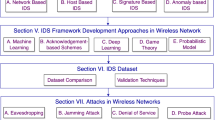Abstract
Mobile ad hoc network (MANET) is defined as the category of wireless network that is capable of operating without any fixed infrastructure. The main assumption considered in this network is that all nodes are trusted nodes but in real scenario, some nodes can be malicious node and therefore can perform selective dropping of data packets instead of forwarding the data packets to the destination node. These malicious nodes behave normally during route discovery phase and afterwards drop fractions of the data packets routed through them. Such type of attack is known as smart gray hole attack which is variation of sequence number based gray hole attack. In this paper, we have launched smart gray hole attack and proposed a new mechanism for mitigating the impact of smart gray hole attack. Mitigating Gray hole Attack Mechanism (MGAM) uses several special nodes called as G-IDS (gray hole-intrusion detection system) nodes which are deployed in MANETs for detecting and preventing smart gray hole attack. G-IDS nodes overhear the transmission of its neighbouring nodes and when it detects that the node is dropping the data packets which are greater than threshold value then it broadcast the ALERT message in the network notifying about the identity of malicious node. The identified malicious is then blocked from further its participation by dropping the request and reply packet. In order to validate the effectiveness of our proposed mechanism, NS-2.35 simulator is used. The simulation results show that the proposed mechanism performs slightly well as compared with the existing scheme under smart gray hole attack.



























Similar content being viewed by others
References
Funde, R., & Chandre, P. (2015). Dynamic cluster head selection to detect gray hole attack using intrusion detection system in MANETs. In Proceeding of ICCCT ‘15, ACM, September 25–27, 2015. Allahabad, India. http://dx.doi.org/10.1145/2818567.2818581.
Murthy, C. S. R., & Manoj, B. S. (2004). Ad hoc wireless networks: Architectures and protocols. Prentice Hall PTR.
Sharma, B. (2015). A distributed cooperative approach to detect gray hole attack in MANET. In Proceeding of WCI, ACM, Kochi, India. http://dx.doi.org/10.1145/2791405.2791433.
Deng, H. M., Li, W., & Agrawal, D. P. (2002). Routing security in wireless ad hoc networks. IEEE Communication Magazine, 40(10), 70–75.
Perkins, C. E., Beliding-Royer, E., & Das, S. (2004). Ad hoc on-demand distance vector (AODV) routing. IETF Internet Draft, MANET working group.
Johnson, D. B., Maltz, D. A., & Hu, Y-C. (2004). The dynamic source routing protocol for mobile ad-hoc network (DSR). IETF Internet Draft.
Heydari, V., & Yoo, S.-M. (2015). E2EACK: An end-to-end acknowledgment-based scheme against collusion black hole and slander attacks in MANETs. Springer Wireless Network, New York. doi:10.1007/s11276-015-1098-6.
Jhaveri, R. H., Patel, S. J., & Jinwala, D. C. (2012). DoS attacks in mobile ad hoc networks: A survey. In IEEE 2nd International Conference on Advanced Computing & Communication Technologies.
Shila, D. M., Cheng, Y., & Anjali, T. (2010). Mitigating selective forwarding attacks with a channel-aware approach in WMNs. IEEE Transactions on Wireless Communications, 9(5), 1661–1675.
Jhaveri, R. H., & Patel, N. M. (2015). A sequence number based bait detection scheme to thwart gray hole attack in mobile ad hoc networks. Springer Wireless Network, 21, 2781–2798. doi:10.1007/s11276-015-0945-9.
Vani, A., & Jadhao, M. M. (2013). Eliminating co-operative black hole and gray hole attacks using modified EDRI table in MANET. In Proceeding of IEEE International Conference on Green Computing, Communication and Conservation of Energy (ICGCE), pp. 944–948.
Mohanapriya, M., & Krishnamurthi, I. (2014). Modified DSR protocol for detection and removal of selective black hole attack in MANET. Elsevier Computers and Electrical Engineering, 40, 530–538.
Marti, S., Giuli, T. J., Lai, K., & Baker, M. (2000) Mitigating routing misbehavior in mobile adhoc networks. In Proceedings of MOBICOM’2000, pp. 255–265.
Ramaswamy, S., Fu, Hu., Sreekantaradhya, M., Dixon, J., & Nygard, K. (2003). Prevention of cooperative black hole attack in wireless ad hoc networks. In Proceedings of ICWN’03, pp. 570–575.
Shahabi, S., Ghazvini, M., & Bakhtiarian, M. (2015). A modified algorithm to improve security and performance of AODV protocol against black hole attack. Springer Wireless Network. doi:10.1007/s11276-015-1032-y.
Gurung, S., & Saluja, K. K. (2014). Mitigating impact of blackhole attack in MANET. In Proceedings 5th International Conference on Recent Trends in Information, Telecommunication and Computing, pp. 229–237. doi: 02.ITC.2014.5.560.
Banerjee, S. (2008). Detection/removal of cooperative black and gray hole attack in mobile ad hoc networks. In Proceedings of the World Congress on Engineering and Computer Science, WCECS, October 22–24, SanFrancisco, USA.
Su, M. Y. (2011). Prevention of selective black hole attacks on mobile ad hoc networks through intrusion detection systems. Elsevier Computer Communication.
Sen, J., Chandra, M. G., Reddy, H., & Balamuralidhar, P. (2007). A mechanism for detection of gray hole attack in mobile ad hoc network. In Proceedings of the IEEE ICICS.
The network simulator-ns-2. (2015). http://www.isi.edu/nsnam/ns/.
Acknowledgments
The first author would like to thank Department of Electronics and Information Technology (DEITY), Government of India, for providing financial support to carry out the research work. The authors would also like to thank the anonymous reviewers and the editors for giving valuable suggestions in improving this paper.
Author information
Authors and Affiliations
Corresponding author
Rights and permissions
About this article
Cite this article
Gurung, S., Chauhan, S. A novel approach for mitigating gray hole attack in MANET. Wireless Netw 24, 565–579 (2018). https://doi.org/10.1007/s11276-016-1353-5
Published:
Issue Date:
DOI: https://doi.org/10.1007/s11276-016-1353-5




